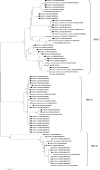Prevalence and clinical characterization of a newly identified human rhinovirus C species in children with acute respiratory tract infections
- PMID: 19625482
- PMCID: PMC2738104
- DOI: 10.1128/JCM.00745-09
Prevalence and clinical characterization of a newly identified human rhinovirus C species in children with acute respiratory tract infections
Abstract
Human rhinovirus C (HRV-C) is a newly identified genotype of HRV found in patients with respiratory tract infections (RTIs); however, its epidemiological profile and clinical characteristics are not well understood. In this study, Chinese children with RTIs were screened for HRV-C and their epidemiological and clinical characteristics were analyzed. From December 2006 to November 2007, 406 nasopharyngeal aspirates from children younger than 14 years of age with RTIs were screened for HRV and other common respiratory viruses by PCR or reverse transcription-PCR. Two-hundred twenty-four (55.2%) of the specimens were infected with at least one virus, including 53 patients with HRV (13%). HRV-A, HRV-B, and HRV-C were detected in 22, 12, and 19 specimens, respectively. HRV-C was detected mainly from December 2006 to April 2007 and from October to November 2007, with peaks in December and April (10/19). Acute upper respiratory infection and bronchopneumonia were observed in 53 and 37% of the cases, respectively. The most common symptoms were cough (82%), runny nose (53%), and fever (37%). Wheezing and bronchiolitis were less common in patients infected with HRV-C than in those infected with respiratory syncytial virus (RSV). Partial sequencing of the genes coding for VP4 and VP2 revealed that the HRV-C strains were 56 to 62% identical at the amino acid level to HRV-B and HRV-A reference strains and 80 to 99% identical to HRV-C reference strains. In conclusion, HRV-C is an important cause of RTIs in children, and highly diversified strains of HRV-C are prevalent in China. HRV-C may produce different epidemiological features, and patients infected with HRV-C may exhibit different clinical features from patients infected with RSV or HRV-A/B.
Figures



References
-
- Andrewes, C. H. 1964. The complex epidemiology of respiratory virus infections. Science 1461274-1277. - PubMed
Publication types
MeSH terms
Substances
Associated data
- Actions
- Actions
- Actions
- Actions
- Actions
- Actions
- Actions
- Actions
- Actions
- Actions
- Actions
- Actions
- Actions
- Actions
- Actions
- Actions
- Actions
- Actions
- Actions
- Actions
- Actions
- Actions
- Actions
- Actions
- Actions
- Actions
- Actions
- Actions
- Actions
- Actions
- Actions
- Actions
- Actions
- Actions
- Actions
- Actions
- Actions
- Actions
- Actions
- Actions
- Actions
- Actions
- Actions
- Actions
- Actions
- Actions
- Actions
- Actions
- Actions
- Actions
- Actions
- Actions
- Actions
LinkOut - more resources
Full Text Sources
Miscellaneous

